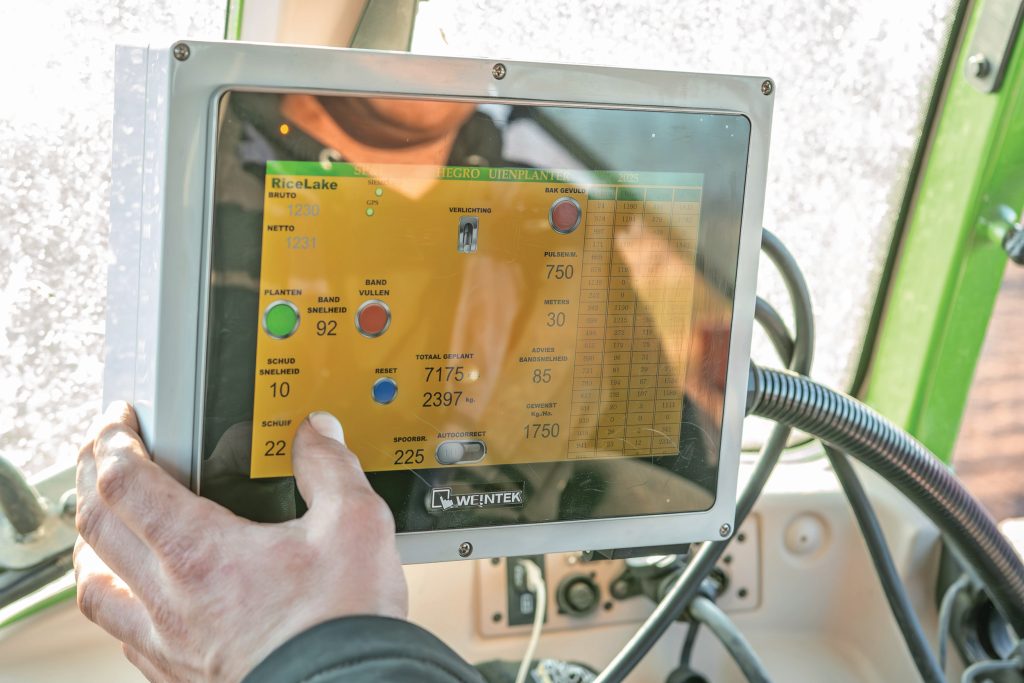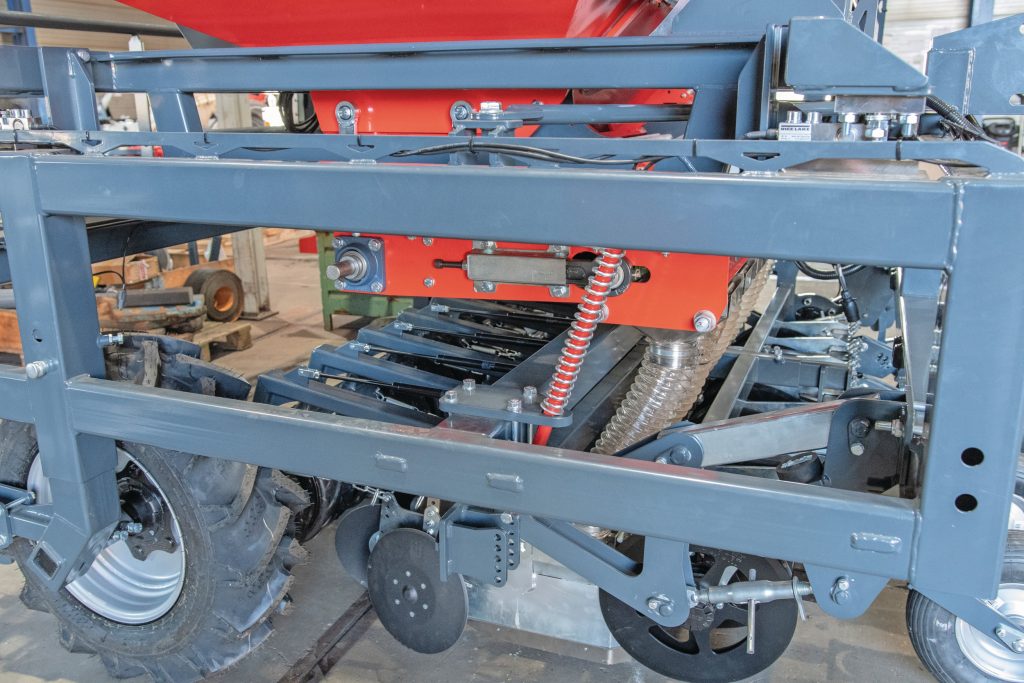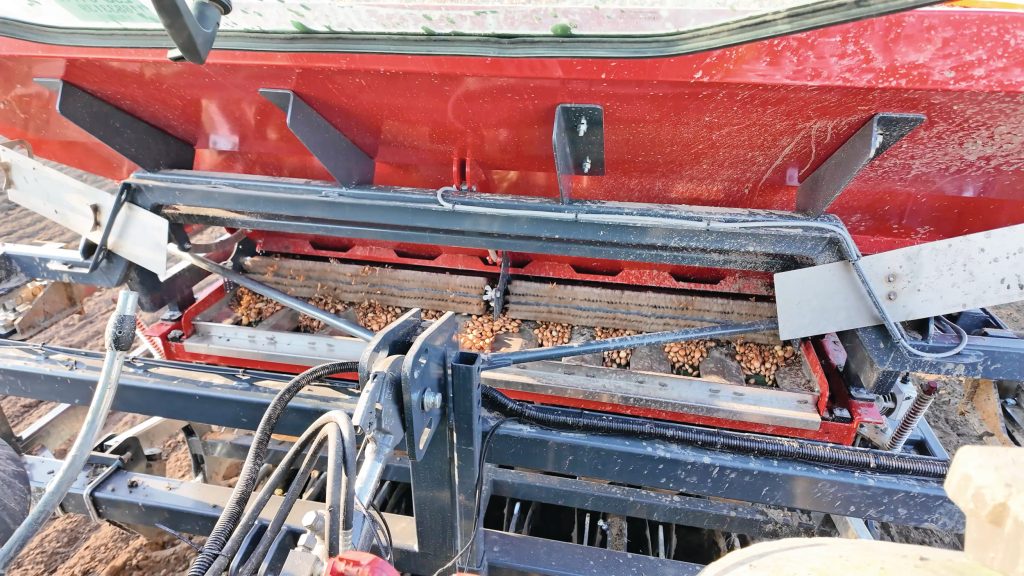Fully electric onion planter saves on labour: HeGro Onionmaster 2.25 plants onions with just 1 operator

The new HeGro Onionmaster 2.25 is a fully electric-powered onion and bulb planter that can be operated by just one person.
Onion planting usually takes 2 or more people: someone in the tractor and another person on the planting machine. Most machines rotate the onions toward the rear, where the second person has a clear view of the planting process and can adjust the thickness of the onion layer on the conveyor belt.
At the headland, there is interaction between the driver and the person handling the settings to check whether the desired planting weight has been achieved. If not, an adjustment follows, and both monitor the next run to see if it is now correct.
Driver controls all functions from the cab
All of these tasks can now be performed by the driver alone from the cab of the HeGro Onionmaster. The 2,700-liter hopper can hold approximately 1,600 kilograms of onions, depending on onion size. The hopper, conveyor belt, vibrating plates, and transparent hoses to the planting coulters are mounted on four load cells. The cab monitor continuously displays the current load of onions on board.
A measuring wheel tracks the driving speed and communicates this data to a PLC (programmable logic controller) at the rear of the machine. The load cells also send data to the PLC, which performs a calculation approximately every 20 meters to verify whether the desired planting rate is being met.
The driver sees the planted distance and amount after each headland turn. There is still a small platform on the back to climb into the hopper, but there’s little else to see here. Passengers can ride along, but the safety bar at the rear could be higher to make this safer.
Monitoring and adjustment from the cab
We join the operator on a round of a one-kilometer-long field. The hopper is just large enough for a single round of planting. In the cab of the Fendt 211 Vario hangs a large white box with a touchscreen display. This screen shows all the essential information needed for precise onion planting.
You input the desired dosage in kilograms per hectare and receive a recommended belt speed. Then you adjust the slide opening to achieve the correct layer thickness—ideally 1.5 onions deep—on the conveyor. At the headland, the system calculates the amount planted in that run, allowing for real-time verification of the settings. In our case, the actual amount deviated by just 7 kilograms from the target of 1,750 kg/ha. Impressive.

Largely built in-house
The machine is mostly built in-house, with the exception of the electrical components, vibrating mechanism, and discharge conveyor, which come from Koops Machines & Techniek in Middenmeer (North Holland), a company well known for its bulb planters and harvesters.
Duport cutting discs—known from fertilizer applicators—are mounted in front of the planting coulters. These V-shaped discs are angled to move soil aside in front of the coulters. They slice through crop residue and clods, preventing blockages and ensuring nothing passes under the coulters. The only wear-prone part of the planting coulters is fitted with replaceable wear strips that can be easily bolted on.
Flexible press wheels are mounted behind the planting coulters. These are spring-loaded with gas springs, applying 90 kilograms of pressure to press the onions firmly into the seedbed. The eight planting units are mounted on a single frame that can oscillate thanks to a parallelogram suspension. Rear gauge wheels and four front depth wheels determine the planting depth.
The coulters themselves are also depth-adjustable. In practice, outer rows are often planted slightly deeper to ensure adequate soil coverage along the edges of the bed. This adjustment is made in 5 mm increments. Planting depth can range from very shallow to over 5 cm deep.

Onionmaster fully electrically powered
The planter runs entirely on electricity. A 1,500 W inverter is installed in the tractor and connected directly to the battery. It converts 12V DC to 220V AC. This setup was chosen for cost reasons. However, the inverter does take up space in the cab, which is not ideal. The manufacturer explains this placement was necessary to keep the inverter as close to the battery as possible.
HeGro deliberately opted for this electric solution, claiming it offers greater precision than hydraulics. It also allows simple communication with the PLC and does not require Isobus. This makes the advanced planter surprisingly user-friendly. It doesn’t take experienced planting staff to operate the machine effectively.

Stable planting depth
The machine weighs 1,850 kg empty. During planting, part of this weight is transferred to the oscillating planting section via two adjustable springs. This results in a stable seedbed at 5 to 6 km/h while reducing pressure on the tractor and machine wheels. The field we visited was on the edge of workable conditions due to clods, yet the elements still held planting depth consistently. The Fendt 211 Vario was just able to lift the planter with a full hopper.
HeGro plans to build a 4.5-meter-wide machine for the next season. The planters are also available in 1.5- and 3-meter versions. The Onionmaster 2.25 is available at a target price of €57,500.



